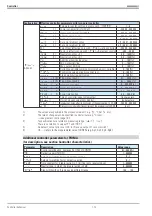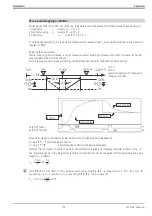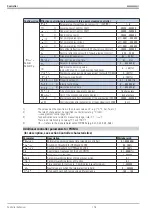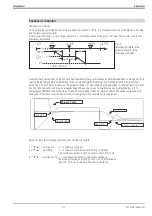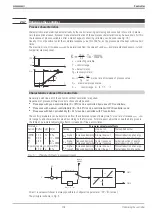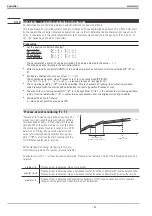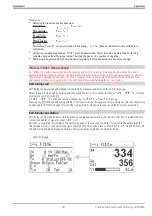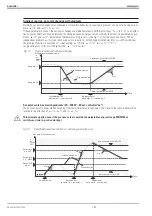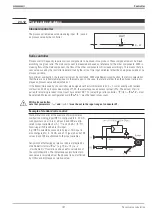
Start from automatic mode:
After self-tuning start, stable correcting variable
YOptm
is output. When ‘Process at rest’ (
PiR
) is detected and a
sufficient set-point reserve (
r
see page 178) is provided, the correcting variable is changed by output step
dYOpt
(boosted with indirect controller, lowered with direct controller).
The self-tuning procedure is realized using the varying process value.
After successful self-tuning, the controller goes to the automatic mode and controls the set-point using the new param-
eters. Parameter
Ores
indicates the self-tuning result (
r
see page 189) .
a
If self-tuning is finished with an error (
Ada_Err
), the stable correcting variable is output, until self-tuning is
finished by the operator via the system menu, front-panel key
H
, or via the interface.
Start from manual mode
To start self-tuning from manual mode, switch the controller to manual. During transition to manual mode, the correct-
ing variable output last is taken over as manual correcting variable. At self-tuning start, this correcting variable is taken
over and output as temporary stable correcting variable. Like in automatic mode, the set-point can be changed at any
time.
With ‘
P
rocess at
r
est
’ (PiR)
detection and a sufficient set-point reserve
(
r
see page 178), the correcting variable is
changed by the correcting variable step
dYOpt
(boosted with indirect controller, lowered with direct controller).
`
P
rocess at
R
est
’
(PiR) can be reached at starting time, i.e. the normal 60 s waiting time can be omitted.
The self-tuning procedure is realized using the varying process value.
After successful self-tuning, the controller goes to the automatic mode and controls the set-point using the new param-
eters. Parameter
Ores
indicates the self-tuning results (
r
see page 189) .
a
When finishing self-tuning with an error (
Ada_Err
), the stable correcting variable is output, until self-tuning
is finished by the operator via system menu, front-panel key
H
, or via interface.
Controller
9499 040 50611
Self-tuning
r
controller adaptation to the process
182
t
t
Y
100%
0%
X
W
60s
PiR
YOptm
dYopt
Optimisation
finished
Start
+
Start
Adaption
Off/Ok
PIR_H
Step
Off/Ok
Fig.: 6
self optimization [grad(x)=0]
t
t
Y
100%
0%
X
W
60
s
PiR
Start Adaption
Optimisation
finished
Start
+
YOptm
dYopt
Off/Ok
PIR_H
Step
Off/Ok
Fig.: 7
self optimization [grad(x)<0]
t
t
Y
100%
0%
X, W
W
X
60s
PiR
Start
H
I
+
+
+
Start
Adaption
Optimisation
finished
> 10% W0/W100
dYopt
Off/Ok
PIR_H
Step
Off/Ok
Fig.: 8
Start by boosting the set-point
t
t
Y
100%
0%
X, W
W
X
60s
PiR
Start
H
D
+
+
Start
Adaption
Optimisation
finished
dYopt
Off/Ok
PIR_H
Step
Off/Ok
Fig.: 9
Start by lowering the correcting variable
Summary of Contents for KS 98
Page 8: ...Description 9499 040 50611 Construction 8...
Page 10: ...Important technical data 9499 040 50611 Further external in and outputs 10...
Page 12: ...Versions 9499 040 50611 I O modules for units with modular option c basic card 12...
Page 14: ...Front view 9499 040 50611 14...
Page 16: ...Mounting 9499 040 50611 16...
Page 26: ...Maintenance 9499 040 50611 Further information 26...
Page 36: ...Scaling and calculating functions 9499 040 50611 LG10 10s logarithm 36...
Page 74: ...Signal converters 9499 040 50611 MEAN mean value formation 74...
Page 128: ...KS98 I O extensions with CANopen 9499 040 50611 RM_DMS strain gauge module 128...
Page 132: ...CSEND Send mod blockno s 21 23 25 27 No 57 132...
Page 140: ...Description of KS98 CAN bus extension 9499 040 50611 140...
Page 202: ...Controller 9499 040 50611 Process value calculation 202...





